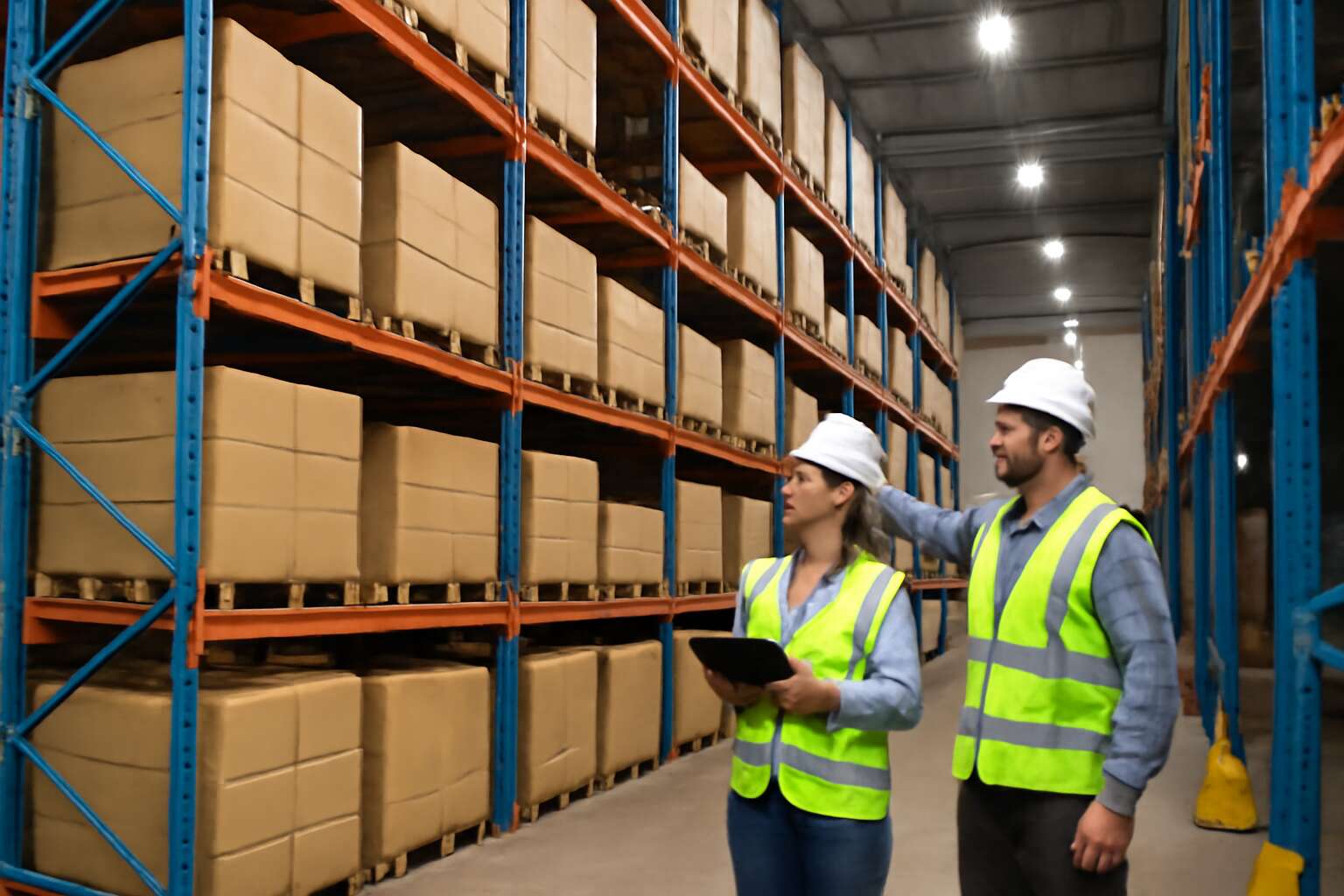Understanding the Importance of WorkSafe in Pallet Racking
Safety Regulations and Standards – Overview of industry safety standards and legal requirements
WorkSafe standards in pallet racking are the backbone of a safe warehouse environment. Studies show that safety violations in storage facilities can lead to serious injuries and costly downtime. That’s why understanding and adhering to industry safety standards is crucial for every operation. These standards are designed not only to protect workers but also to ensure the longevity of the racking system itself.
Legal requirements for pallet racking worksafe vary across regions but generally include regular inspections, proper installation, and load management. Compliance with these regulations reduces the risk of accidents and enhances overall efficiency. For example, following manufacturer guidelines and conducting routine safety audits can prevent collapses and injuries. Remember, a well-maintained pallet racking system isn’t just about safety; it’s a commitment to operational excellence.
Why Pallet Racking Safety Matters – Impacts on workforce safety, business liability, and operational efficiency
WorkSafe standards in pallet racking are more than just regulations—they’re a lifeline for safety in the warehouse. Properly maintained racking systems protect workers from potential accidents that can cause severe injuries or fatalities. Studies reveal that a significant portion of warehouse incidents stem from neglecting pallet racking worksafe practices, leading to costly downtime and legal liabilities.
Prioritising pallet racking worksafe directly impacts operational efficiency. When safety protocols are in place, there’s less chance of collapses or accidental dislodgement of stored goods. This not only safeguards personnel but also preserves the integrity of inventory and minimises equipment damage. For businesses, the message is clear: safety isn’t an added expense—it’s a vital component of productivity and long-term success.
Design Principles for Safe Pallet Racking Systems
Load Capacity and Structural Integrity – Ensuring racks are designed to handle specific load requirements
In the silent, relentless rhythm of a warehouse, the integrity of pallet racking systems stands as a testament to human precision and responsibility. A fragile misstep can cascade into catastrophe, yet the design principles for safe pallet racking systems are founded on a simple truth: robustness isn’t just about strength but about understanding load capacity at a fundamental level. When racks are engineered with meticulous attention to structural integrity, they become silent guardians of safety, capable of bearing the weight of countless pallets without faltering.
To achieve this, designers must consider a multitude of factors—material composition, connection points, and the dynamic forces exerted during everyday operations. A rigorous focus on load capacity ensures racks are not only compliant but resilient. This is where the core principles of pallet racking worksafe come into play: ensuring each component is rated accurately and constructed to withstand the specific demands of your storage environment. After all, safety isn’t an afterthought; it is embedded in the very blueprint of the system.
- Understanding the maximum load per level
- Ensuring proper distribution of weight across the structure
- Designing with future expansion in mind to prevent overloads
When these principles are embraced, the structural integrity of the racking system becomes an unassailable foundation for safe and efficient storage. It’s a moral imperative—one that safeguards lives and sustains trust in our shared commitment to pallet racking worksafe practices.
Accessibility and Ergonomics – Design considerations for safe and efficient handling
Every year, warehouse accidents cost businesses millions in damages and, more critically, can jeopardise lives. Ensuring pallet racking worksafe isn’t just a regulatory box to tick; it’s a moral obligation. One key aspect often overlooked is the importance of accessibility and ergonomics in design. Well-planned racking systems facilitate smooth, safe handling of pallets, reducing strain on workers and preventing accidents before they happen.
Design considerations should prioritise clear pathways, adjustable shelf heights, and easy access points. This not only boosts efficiency but also minimises ergonomic risks, such as repetitive strain injuries. For example, incorporating
- height-adjustable beams
- low-friction rollers
can dramatically improve handling safety. When these features are thoughtfully integrated, the system becomes more than just storage; it transforms into a safe environment where workers can operate confidently and comfortably. Focusing on accessibility and ergonomics is a cornerstone of pallet racking worksafe, reinforcing the idea that safety begins with thoughtful design.
Material Selection – Choosing durable, compliant materials for longevity and safety
In the intricate dance of warehouse management, selecting the right materials for pallet racking worksafe is akin to choosing the perfect choreography—each element must work harmoniously to ensure safety and durability. Material choice is not a mere technicality; it is the backbone of resilient, long-lasting storage solutions that withstand the test of time and tension. Steel, often the stalwart hero, must be alloyed with quality assurance and compliance standards to prevent catastrophic failure. The integrity of the structure hinges on these fundamental choices, transforming a simple rack into a fortress of safety.
Furthermore, the tensile strength and corrosion resistance of materials are paramount, especially in environments prone to moisture or chemical exposure. Incorporating materials that meet industry standards and undergo rigorous testing ensures that the pallet racking system remains steadfast under load, reducing the risk of collapse or damage. When the right materials are thoughtfully selected, it elevates the entire concept of pallet racking worksafe—fortifying the workplace and fostering confidence among those who operate within it.
Best Practices for Installing Pallet Racking Safely
Site Preparation – Preparing the environment for proper installation
Before the first beam is bolted in place, the environment must be meticulously prepared—an often overlooked step that can make or break pallet racking worksafe. A cluttered or uneven floor can undermine structural integrity and jeopardise worker safety. Ensuring the site is level, clean, and free of obstructions is paramount. This initial site preparation sets the foundation for a seamless installation process, reducing the risk of accidents and ensuring compliance with safety standards.
Careful planning extends beyond mere cleanliness. Identifying potential hazards, such as uneven surfaces or restricted access points, allows for proactive mitigation. During installation, employing proper equipment—such as forklifts and safety harnesses—further enhances the overall safety. For optimal pallet racking worksafe, consider implementing a checklist that covers:
- Surface assessment and level verification
- Clear marking of pathways
- Designated storage zones for tools and materials
- Proper lighting and ventilation
This strategic approach not only supports efficient assembly but also safeguards personnel, elevating safety from the outset. After all, a well-prepared site is the cornerstone of enduring pallet racking safety and operational resilience.
Installation Procedures – Step-by-step guidelines for secure assembly
In the pursuit of impeccable pallet racking worksafe, precision and patience are paramount. The installation process, often viewed as routine, demands a meticulous approach—each step an act of safeguarding lives and ensuring long-term stability. When assembling pallet racking, it’s essential to follow a disciplined sequence, transforming a chaotic warehouse into a sanctuary of safety and efficiency.
Begin with a thorough site assessment: verify that the floor is perfectly level and free from debris. This foundational step ensures that the structural integrity of the racking system remains uncompromised. Once the environment is prepared, proceed with the assembly—starting with anchoring the upright frames securely to the floor.
- Ensure all components are clean, undamaged, and compliant with industry standards.
- Follow manufacturer instructions diligently, paying close attention to torque specifications for bolts and fasteners.
Throughout the installation, utilise appropriate equipment—such as forklifts for heavy lifting and safety harnesses to prevent falls. Maintaining clear pathways and marking designated zones for tools and materials helps keep the workspace organised. These practices, woven into every phase of assembly, elevate pallet racking worksafe from mere compliance to a culture of vigilance and care. After all, safety is an art, crafted through deliberate steps and unwavering attention to detail.
Use of Qualified Professionals – Ensuring certified experts handle installation
When it comes to installing pallet racking worksafe, entrusting the task to qualified professionals isn’t just a wise choice — it’s a non-negotiable. Certified experts bring a wealth of experience, understanding the nuances that can turn a potential disaster into a seamless operation. Their specialised training ensures that each bolt is tightened to the right torque, each upright perfectly aligned, and every safety protocol meticulously observed. After all, a single oversight can turn a sturdy rack into a hazard zone faster than you can say “forklift accident”.
To elevate safety standards, consider forming a team of experts who prioritise compliance and precision. These professionals should adhere to industry best practices, including:
- Conducting a thorough site assessment before starting the installation
- Using specialised tools and equipment designed for pallet racking worksafe
- Following manufacturer instructions to the letter, ensuring every component is correctly assembled
By relying on skilled installers, businesses can significantly reduce the risk of structural failure and optimise operational efficiency. After all, investing in qualified professionals isn’t just about ticking boxes — it’s about creating a resilient, safe environment where productivity can flourish without fear of falling racks or shoddy assembly. Because, in the world of pallet racking, safety isn’t an afterthought — it’s the foundation of everything.
Routine Inspection and Maintenance for Pallet Racking Safety
Inspection Checklist – Regular checks for damage, corrosion, and wear
Routine inspection and maintenance are the backbone of pallet racking worksafe. Regular checks ensure that damage, corrosion, and wear are identified early, preventing accidents before they happen. Over time, even the strongest racks can suffer from structural fatigue or material degradation, which compromises safety and operational efficiency.
A proactive approach involves scheduled visual inspections to spot signs of deterioration such as bent beams, loose bolts, or rust. These small issues, if ignored, can escalate into serious safety hazards. Incorporating a simple yet thorough inspection routine—perhaps weekly or monthly—can make all the difference.
Some facilities adopt a checklist that covers key inspection points, like stability, load distribution, and clear signage. This systematic approach helps maintain high standards of pallet racking worksafe, ensuring equipment remains secure and fit for purpose. Remember, safety isn’t a one-time effort—it’s an ongoing commitment.
Maintenance Schedule – Timely repairs and part replacements to prevent accidents
In the shadowed corridors of industry, where steel whispers tales of strength and vulnerability, routine inspection and maintenance emerge as the silent guardians of pallet racking worksafe. Every bolt, beam, and joint bears the weight of unseen forces—corrosion creeping like shadows, wear eroding the resilience beneath a veneer of durability. Neglecting these signs is akin to inviting chaos into a fortress of order, risking catastrophic collapse.
Timely repairs and part replacements are the antidote to such peril. They serve as a vigilant sentinel, ensuring that the structural integrity of the racks remains unbroken. Regular checks—be they weekly or monthly—are not mere formalities but vital rituals that stave off the slow decay that endangers lives and livelihoods. A systematic approach, perhaps guided by an ordered list of inspection points, can illuminate the subtle cracks before they become chasms.
Record Keeping – Tracking inspections and maintenance history
In the silent, rhythmic heartbeat of industry, the integrity of pallet racking stands as a testament to human ingenuity and care. Yet, beneath this facade of strength lies a fragile balance—an intricate dance of safety and vigilance that must be meticulously maintained. Routine inspection and maintenance are not mere administrative tasks; they are the moral backbone of pallet racking worksafe, holding the fabric of operational safety together.
Keeping a comprehensive safety record is essential. It transforms sporadic checks into an ongoing narrative—one that captures every crack, rust spot, or unwarranted deformation. Such documentation creates a living history, enabling managers to anticipate potential failures before they manifest catastrophically. An effective safety record keeps the focus sharp and the response swift, ensuring that each inspection becomes a line in a serious ledger of accountability and care.
To bolster these efforts, a well-structured approach can be employed. An ordered list of inspection points ensures nothing is overlooked, from the sturdiness of beams to the corrosion levels lurking in shadowed corners. Maintaining this detailed chronicle not only aligns with legal standards but also embodies a profound respect for the human lives that depend on these structures. In the realm of pallet racking worksafe, every logged inspection is a silent promise—an unwavering commitment to safety, durability, and human dignity.
Training and Staff Awareness for Pallet Racking Safe Practices
Employee Training Programs – Educating staff on safe handling and emergency procedures
In the shadowed corridors of industry, where unseen dangers lurk beneath the mundane, the importance of employee training in pallet racking worksafe cannot be overstated. A well-informed workforce is the first line of defence against catastrophe; awareness transforms workers from passive observers into vigilant guardians of safety.
Enlightening staff about proper handling procedures and emergency protocols creates a culture where safety is woven into every task. For instance, training should emphasise the critical importance of secure load distribution and recognising early signs of structural wear. To foster this, companies often implement comprehensive employee training programs that include practical drills and visual aids, ensuring that safety becomes second nature.
- Understanding load limits and load balancing
- Recognising warning signs of rack damage
- Responding swiftly to emergencies
When staff are equipped with knowledge, they become the architects of a safer environment—one where the silent menace of neglect is kept at bay by the vigilant eyes of those who know best. In this dance of steel and shadows, ongoing education and heightened staff awareness serve as the unyielding guardians of pallet racking worksafe.
Signage and Safety Labels – Using visual aids to promote awareness
In the silent ballet of industry, where steel and shadows intertwine, visual aids such as pallet racking safety signage and safety labels serve as silent sentinels—constant reminders of the importance of vigilance. These visual cues are more than mere markers; they are the language of safety etched into every corner of the warehouse, transforming abstract protocols into tangible, accessible knowledge. An effective signage strategy does more than comply with regulations; it cultivates a culture of awareness where every worker instinctively recognises hazards and responds with informed precision.
To maximise their impact, safety labels should be strategically positioned at key points—near load areas, at rack joints, and on control panels—ensuring that safety messages are unavoidable. Incorporating colour-coded signs and universally recognised symbols heightens comprehension, transcending language barriers and fostering a unified understanding of best practices. This visual lexicon becomes an integral part of the daily workflow, empowering personnel to navigate the intricacies of pallet racking worksafe with confidence and clarity.
Embedding these visual aids into the fabric of warehouse operations not only enhances safety but also reinforces the importance of ongoing staff awareness—an unyielding defence against neglect and oversight. In this dance of precision and protection, sight truly becomes safety, guiding every move in the pursuit of a hazard-free environment.
Reporting Unsafe Conditions – Encouraging prompt reporting of hazards
Within the bustling realm of warehouse safety, fostering a culture of vigilance hinges on more than just signage and structural integrity. Training and staff awareness are the enchanted keys that unlock a truly secure environment. When employees understand the significance of pallet racking worksafe, they become active guardians of their own safety and that of their colleagues. This is where comprehensive training programmes come into play, transforming theoretical safety protocols into instinctive actions.
Encouraging staff to report unsafe conditions promptly is vital. An open communication channel ensures hazards are swiftly addressed before they escalate into disasters. To facilitate this, many organisations implement simple yet effective reporting systems, such as anonymous forms or dedicated hotlines. A proactive approach might involve a list of common hazards that staff can quickly recognise, including:
- Damaged or unstable racking components
- Obstructed aisles or emergency exits
- Overloaded or improperly balanced pallets
By empowering personnel to speak up without fear of reprisal, the entire warehouse becomes a living, breathing safety network. When every worker views hazard reporting as an integral part of their role, the collective shield of pallet racking worksafe grows stronger, creating an environment where accidents are diminished and confidence flourishes. This mutual vigilance echoes the timeless truth that safety is a shared journey—one navigated best when everyone is alert, informed, and committed to proactive intervention.
Technological Solutions to Enhance Pallet Racking Safety
Monitoring Systems – Implementing sensors and cameras for real-time safety checks
In the bustling world of warehousing, technology now offers a lifeline to bolster pallet racking worksafe. Advanced sensors and cameras are transforming safety monitoring from reactive to proactive, capturing real-time data that helps prevent accidents before they happen. These innovations enable continuous surveillance of pallet racking systems, detecting irregularities such as shifting loads, structural stress, or potential damage.
Implementing these technological solutions means integrating a network of smart devices that communicate seamlessly with safety protocols. For example, sensors can alert staff immediately if a load exceeds safe limits or if a rack shows signs of wear—reducing the risk of catastrophic failures. Cameras, with their high-definition feeds, provide clear visuals of racking conditions, allowing for swift intervention.
- Load monitoring sensors that detect overloading
- Infrared cameras to identify heat or corrosion
- Motion detectors to monitor access points and prevent unauthorised entry
- Data analytics platforms to track trends and predict maintenance needs
Together, these technological solutions form a resilient shield around warehouse operations, ensuring pallet racking worksafe is maintained at every turn. The integration of sensors and cameras not only enhances safety but also fosters a culture of vigilance and accountability—where safety is an ongoing, dynamic priority.
Automation and Robotics – Reducing human error with automated handling
In the relentless pursuit of safety within warehouse labyrinths, technological solutions serve as a beacon of hope—illuminating unseen dangers lurking in shadowed corners. Automation and robotics stand at the forefront, transforming pallet racking worksafe from mere compliance into a dynamic fortress of protection. Automated handling systems, guided by precise algorithms, drastically reduce human error, which remains a leading cause of racking accidents. These intelligent machines not only enhance efficiency but also act as vigilant custodians, meticulously manoeuvring loads with unwavering consistency.
By integrating advanced robotics, warehouses can achieve a symphony of flawless operations. For instance, automated guided vehicles (AGVs) and robotic arms can handle heavy loads, alleviating the physical strain on staff and diminishing the risk of mishaps. This technological ballet ensures that each pallet is placed with the delicate precision that sustains structural integrity and upholds pallet racking worksafe standards.
- Precise load placement
- Consistent handling procedures
- Instant error detection and correction
As these cutting-edge systems weave into the fabric of warehousing, they forge a resilient barrier against the chaos of human oversight. The marriage of automation and robotics does not merely support safety; it elevates it to an art form—where vigilance becomes instinct and accidents are thwarted before they can materialise. In this brave new realm, safety isn’t just a protocol—it’s a living, breathing entity that safeguards every inch of the racking landscape, ensuring that pallet racking worksafe is a promise kept at every turn.
Software Management Tools – Digital tracking of inspections and maintenance
In the intricate dance of warehouse management, safety often hinges on unseen threads—digital tools that silently monitor, record, and optimise. Technological solutions have revolutionised how we approach pallet racking worksafe, transforming reactive measures into proactive safeguards. Digital tracking of inspections and maintenance, for instance, ensures that every component is scrutinised with relentless precision, exposing vulnerabilities before they manifest into hazards.
By harnessing advanced software management tools, organisations can maintain an up-to-the-minute overview of their racking infrastructure. These systems facilitate real-time updates, scheduled audits, and comprehensive records—creating a resilient backbone for safety protocols. An ordered system of
- inspection logs
- maintenance schedules
- damage reports
ensures that no detail is overlooked, and compliance is baked into daily routines. Such meticulous oversight fortifies the integrity of pallet racking worksafe, preventing accidents rooted in neglect or oversight.
Ultimately, the integration of digital tracking tools does more than streamline operations—it embodies a moral commitment to safeguarding every worker. As warehouses evolve into smarter environments, these technological solutions serve as both guardians and guides, ensuring that safety remains an active, living principle woven into the very fabric of warehouse life.
Legal Implications and Responsibilities for Pallet Racking Safety
Worker Compensation and Liability – Understanding legal responsibilities
When it comes to pallet racking worksafe, understanding the legal implications is paramount. Failure to adhere to strict safety standards can lead to severe penalties, lawsuits, and even criminal charges. Employers are legally responsible for providing a safe working environment, which includes ensuring that pallet racking systems are installed, maintained, and operated in compliance with national safety regulations. Non-compliance not only jeopardises worker safety but also exposes your business to significant liability.
Liability in the event of an accident often extends beyond just financial repercussions. Compensation claims from injured workers can be extensive, potentially damaging your organisation’s reputation. It’s essential to recognise that legal responsibilities encompass both proactive safety measures and reactive incident management. Regular documentation of inspections, maintenance, and staff training is not just good practice but a legal safeguard. In fact,
- failure to report unsafe conditions
- neglecting routine checks
can be viewed as gross negligence in court, increasing your legal exposure.
Compliance Audits – Preparing for inspections and certifications
Legal compliance isn’t merely a box to tick; it’s the very foundation of a safe and resilient warehouse environment. When it comes to pallet racking worksafe, understanding the legal implications is vital for safeguarding your workforce and your reputation. Regulatory inspections are rigorous, and failing to meet them can result in hefty fines or even criminal charges. Preparing for these audits requires meticulous documentation—recording inspections, maintenance routines, and staff training sessions to demonstrate adherence to national safety standards.
To ensure a smooth certification process, consider implementing a comprehensive inspection checklist. This should include verifying load capacities, checking for corrosion, and confirming that safety labels are visible and up-to-date. Employing qualified professionals for installation and regular assessments not only enhances safety but also minimises legal risks. Remember, proactive compliance is the best defence against unforeseen liabilities, transforming safety from a burden into a strategic advantage in your operational landscape.
Consequences of Non-Compliance – Risks and penalties for safety violations
In the shadowy corridors of warehouse management, a single lapse in pallet racking worksafe can unleash chaos, risking not just assets but lives. Legal implications loom large for those who neglect these vital safety protocols. Non-compliance with safety standards does not merely invite fines; it can lead to devastating accidents, legal sanctions, and irreparable damage to reputation. The stakes are high, and the consequences of safety violations extend beyond financial penalties, threatening the very fabric of operational integrity.
Failure to adhere to strict safety regulations can result in severe risks, including structural collapses or worker injuries. These hazards often attract hefty fines or even criminal charges, especially if negligence is proven. To illustrate, safety violations related to pallet racking can lead to fines that cripple a business’s bottom line or, worse, legal actions that tarnish its standing in the industry. It’s a stark reminder that maintaining pallet racking worksafe is not optional but an essential pillar of responsible warehouse stewardship.
Understanding your legal responsibilities is crucial. Here’s a glimpse into the gravity of non-compliance:
- Financial penalties that can escalate into thousands of pounds.
- Legal proceedings that may result in criminal liability.
- Increased insurance premiums or loss of coverage.
- Reputational damage that can linger long after the incident.
In this delicate dance of safety and legality, proactive measures are your best defence. Ensuring your pallet racking system is compliant and well-maintained not only safeguards your personnel but also fortifies your business against unforeseen legal repercussions. When safety becomes a strategic priority, it transforms from a mere obligation into a formidable shield against the tumult of potential calamities. The true power lies in recognising that every action taken to uphold pallet racking worksafe is an investment in resilience and peace of mind.




0 Comments